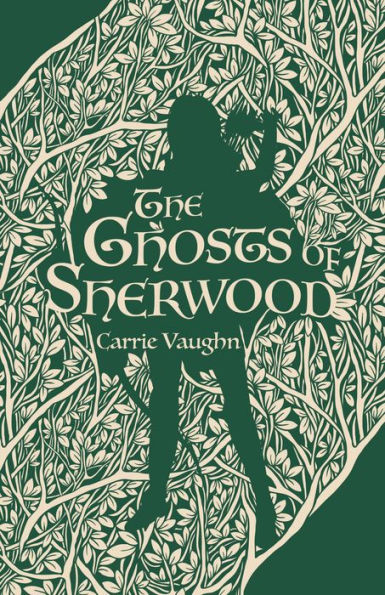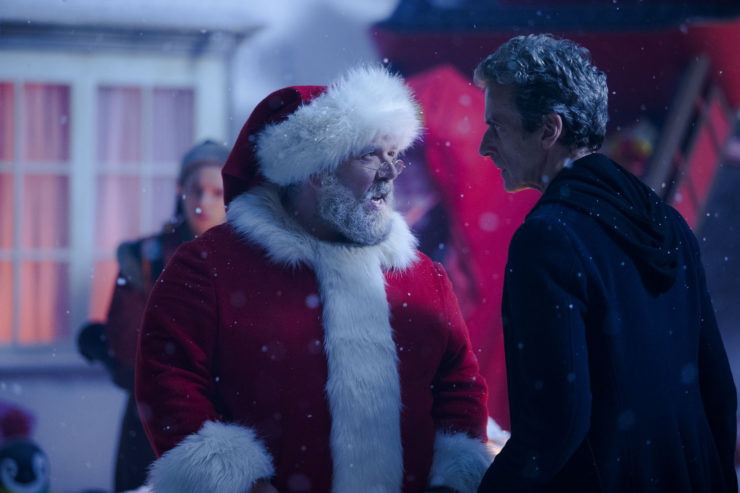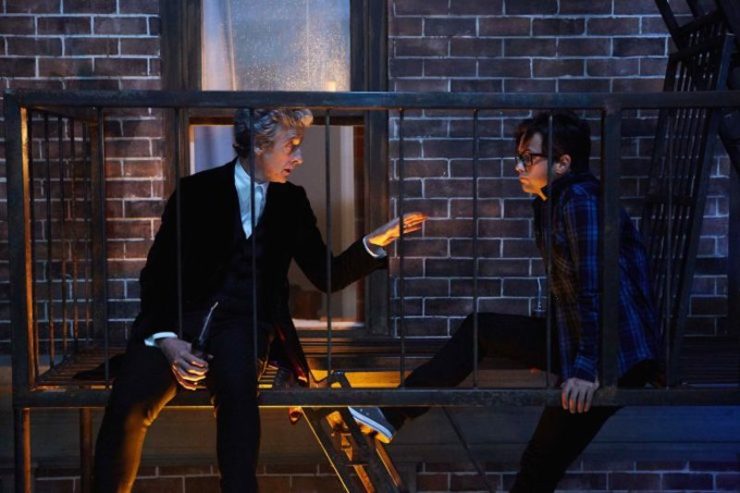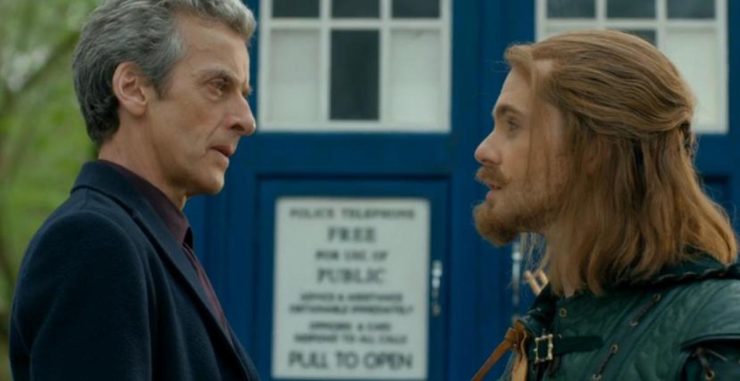It’s rare that you can pinpoint not only the exact episode, but the precise line, when Doctor Who invents a new subgenre. The Twelfth Doctor spends most of “Robot of Sherwood” (2014) certain that Robin Hood—green tights, Merry Men, the whole shebang—must be a hologram, or a theme park attraction, or even a robot controlled by the Sheriff of Nottingham. A story to give the peasants false hope. Until the Sheriff points out what a terrible idea that is. “But he can’t be,” the Doctor says. “He’s not real. He’s a legend!” At which point Robin fires another quip from his quiver: “Too kind!”
With nearly every modern season of Doctor Who featuring famous faces like Charles Dickens, Vincent van Gogh, or Queen Elizabeth, visiting Sherwood Forest might seem like just a modest twist on the established “celebrity historical” format. But it was the start of the Peter Capaldi era as a stark exception: not a single one of his episodes featured real historical figures. Instead, across five episodes, Capaldi’s Doctor faced a pantheon of gods and folk heroes—Robin Hood, Santa Claus, the great Odin, a store-brand Superman, and finally, the most mythic figure the Doctor could ever face: himself. And lo! The celebrity historical fell into myth and legend, with a new subgenre I’m dubbing the “celebrity mythological.”
[Spoilers for Series 8-10 of Doctor Who, plus the existence of Santa Claus]
From climbing Rapunzel’s hair in a surreal Land of Fiction, to flushing Satan down a black hole, the Doctor’s met plenty of myth makers in some pretty tall tales. And yes, the celebrity historical relies on mythologizing real people, particularly “great men,” who must learn to live up to their own legends. But it’s not just that the reality of a ridiculous rogue like Robin Hood is given the same deference as Winston Churchill or Rosa Parks. What makes the celebrity mythological distinctive is how it makes “real” people out of myths, who must confront either their own fictionality, or the Doctor’s. As the Earl of Loxley tells the Lord of Time, “I’m just as real as you are.”
Buy the Book


The Ghosts of Sherwood
The Doctor and Robin Hood are mirrored both as personalities and as equally “impossible heroes.” They compete, tied up in chains, over which one gets to be interrogated by the Sheriff. They compete in swordfights to win the favor of the Doctor’s companion Clara. And they compete over the narrative, with Robin Hood’s heroic ballad sparring against Doctor Who’s conventions in a 45-minute screwdriver-and-arrow-measuring contest. It’s only by setting aside their machismo and seeing their commonalities, as privileged men who help those less fortunate, that both characters symbolically cede narrative space. As much as Robin Hood has to accept the Doctor’s world of spaceships, so too must the Doctor compromise with Robin’s world, where that spaceship might have a bullseye on its engine that they have to shoot with a golden arrow. For once, Doctor Who doesn’t win out, because both worlds are stories. On learning that he’s only remembered as a legend, Robin says, “Good. History is a burden. Stories can make us fly.” In his final act of heroism, he accepts his own metafiction. Whereas the Doctor insists he’s not a hero, for Robin that’s entirely the point: “Well, neither am I. But if we both keep pretending to be—ha, ha! Perhaps others will be heroes in our name. Perhaps we will both be stories. And may those stories never end.” To be a hero, or even to be “real,” means simply trying, or pretending, to live your own fiction.
This theme can be immediately traced back to the 50th anniversary special “The Day of the Doctor” (2013), when the legendary John Hurt exploded out of the Doctor’s timeline like an alien chestburster. This so-called War Doctor had given up the name, having failed the Doctor’s values in wartime. But like a name, this idea was passed down to Capaldi. Suddenly, being “the Doctor” was less of an alias than an alter ego, bound up in ideals like “never cruel or cowardly” and “never give up, never give in”—ideals the Doctor tries, and sometimes fails, to live up to. The Capaldi era obsesses over this separation between “the Doctor” and the Doctor, the role and the character who plays him. The title is a promise others can take on too, with Clara trying to be more and more like the Doctor until, in “Hell Bent” (2015), she gets to steal a TARDIS and run away. And it’s a promise the Doctor doesn’t always keep. “The Doctor is no longer here!” he threatens. “You are stuck with me.”
By recasting the Doctor as a mythic role, even for himself, Doctor Who was grappling with the promise and peril of having lasted so long as a series. Both the character and the show had now regenerated 12 times, replacing actors and writers and producers over and over like a televisual Ship of Theseus until, as the Doctor says in “Deep Breath” (2014), “there’s not a trace of the original you left.” And having regenerated into a grumpier persona, he broods over whether he’s intrinsically “a good man,” or if he’s just performatively a hero, thanks to 2,000 years of muscle memory. These are transparently metafictional questions. By the Capaldi era, the show had not only survived but exorcised the trauma of its 1989 cancellation, becoming the most-watched British drama in 2013. But in the afterglow of its 50th anniversary, certain questions naturally emerged: Is the show still “good”? Is it even the same show, half a century on? And what’s the point of making it anymore?

Of course, in Britain, even Doctor Who’s biggest naysayers know what the point of it is. It’s for the kids. So “Last Christmas” (2014) pits the Doctor against the most famous children’s hero of all. The Doctor and Clara arrive in a scientific base at the North Pole, where Santa Claus and his comedy elves rescue them from facehugging Dream Crabs, who induce a dream state in their victims’ minds. The central joke, of course, is that Santa is a ridiculous fantasy. But then, so is the Doctor. Even Clara compares believing in Santa to believing in the Doctor. Which is why Santa—played by Nick Frost in a surprising bit of nominative determinism—tries to convince Clara and the base’s scientists that they’re all asleep, slowly getting digested by the Dream Crabs with Inception-style dreams within dreams. Their subconscious is fighting back with impossible fictions: not just “me, Sweet Papa Chrimbo” and his flying reindeer, but also “a time-travelling scientist dressed as a magician” and his magic phone box. But building on Robin Hood challenging the Doctor’s reality, Santa seems to tease that being fictional isn’t all bad. “You’re a dream who’s trying to save us?” a scientist asks, and he replies, “Sweetheart, I’m Santa Claus. I think you just defined me!”
After all, the Doctor is the only folk hero clever enough to realize he’s a dream. “Before the Flood” (2015) opens with a sci-fi lecture delivered straight down the lens: “This is called the Bootstrap Paradox. Google it.” Trapped and alone in “Heaven Sent” (2015), he glances at the screen and says, “I’m nothing without an audience.” And when a computer-generated version discovers he’s literally fictional, trapped in a perfect simulation of Earth for a perfect invasion strategy, the very idea of the Doctor fights back. “Oh, you don’t have to be real to be the Doctor. Long as you never give up. Long as you always trick the bad guys into their own traps.” The implication is that the Doctor doesn’t just save his fictional universe: he saves you, the viewer, the fan, the person reading this now. And he knows it.
Emphasis on “he”. Because along with metafiction, masculinity is the telltale sign of Capaldi’s celebrity mythological stories. All five celebrities are mythical men, who embody qualities and narratives the Twelfth Doctor—the last of the exclusively male Doctors—must embrace or reject. It’s most noticeable in “The Girl Who Died” (2015), where a fake Odin is stealing Vikings to grind into juice: “Testosterone, extracted from the finest warriors. Ahh! Nectar!” Toxic masculinity in a shot glass. But when the Viking girl Ashildr, played by Game of Thrones star Maisie Williams, challenges Fake Odin to battle, the Doctor is left with 24 hours to whip the surviving, far less manly Vikings into shape. Their role as warriors, as men, and as Vikings operates as a kind of story they refuse to escape from.
So the Doctor offers up a different story. They throw a party and hack the aliens’ technology to trick them into seeing a terrifying dragon from Ashildr’s imagination. “An army like yours, it lives or dies on its reputation, its story,” the Doctor says, while Clara shows a recording of Fake Odin’s warriors running scared. “If you don’t leave right now, I’ll put it out there for all to see, and no one will fear you again.” The Doctor claims victory in his epic battle against a Norse god by simply embarrassing him with a viral video. While puncturing both his and Fake Odin’s masculinity, the episode also complicates the audience’s folk memory of the Doctor as a “lonely god” when they realize Ashildr had died in the battle. Accepting his role as an almost godlike savior, he uses some of the aliens’ tech to revive Ashildr. This makes her functionally immortal, and makes the Doctor, in a sense, her (all)father.
The fourth celebrity mythological story takes flight as an homage to old-fashioned superheroes, with The Ghost explicitly standing in for Christopher Reeve’s Superman. But it’s his secret identity, Grant Gordon, whose issues with fatherhood and romance “The Return of Doctor Mysterio” (2016) soon settles on. With a suitably meta origin story as a comicbook-loving kid who meets the Doctor and accidentally eats a magic gemstone from space, Grant balances life as a Man of Steel with life as a mild-mannered nanny for his high school sweetheart Lucy Lombard. These two lives coalesce with Grant wearing a baby monitor strapped to his superhero costume, juxtaposing two visions of masculinity. The real superhero, then, is Grant rather than The Ghost: the secret identity who, like the Doctor, has to pretend to be someone else, while really saving the everyday with ordinary love, not superpowered fists.

Though the Doctor toys with the nickname Doctor Mysterio, the episode has little interest in equating him to a superhero. Instead, it treats the Doctor as a surrogate father and, like Grant, a hopeless romantic interest. He checks in on Grant throughout his childhood, imploring him not to use his powers, teaching him the facts of his new life, even when puberty gives him uncontrollable X-ray vision. And whereas Grant struggles to start a relationship with Lucy after 24 years, the Doctor has just ended 24 years with his wife River Song. “Man or myth?” had been the overriding question for the Doctor, but by Capaldi’s final year, the Doctor being a man specifically, exclusively, was something the show had to confront—and change.
Both the celebrity mythological subgenre and Capaldi’s Doctor end with “Twice Upon a Time” (2017), as he encounters the most mythic celebrity of all: himself. The First Doctor, played by David Bradley in William Hartnell’s place, wanders away from his last Dr Who straight into modern Doctor Who—from the days when he was simply the Doctor, to a time when the name “Doctor” has gotten bigger than he could have imagined: “The Butcher of Skull Moon. The Last Tree of Garsennon. The Destroyer of Skaro. He is the Doctor… of War.” Both Doctors refuse to regenerate, insisting on the right “to live and die as myself,” and facing the mythic heft of 21st century Doctor Who hardly persuades the First Doctor otherwise. He’s portrayed as a quaint scientific explorer who left home to analyze what “logic” or “mysterious force” allows good to triumph over evil, never realizing that in searching, in putting things right wherever he lands, he unwittingly creates his own mythic destiny. “You were right,” the Twelfth Doctor tells his original self. “The universe generally fails to be a fairy tale. But that’s where we come in.”
This is what gives him a reason to regenerate. Far from there being “not a trace of the original you left,” the Twelfth Doctor relearns Doctor Who’s same old story of change and renewal. By this point, the contradiction between “the Doctor’s” universal ideas and the Doctor’s far from universal casting had become painfully obvious, and most folk heroes never break free from a contradiction like that. Robin Hood never really changes, even if his shtick wears a bit thin. There’s only one Santa Claus in the British and American popular imagination. Even Superman is timeless. But hero or dream, repentant warrior or father figure, the Doctor has many faces, many lives. None of them are real, but the celebrity mythological reminded us that the Doctor is a myth who saves us, uniquely, by embodying the value of change. If the Doctor can change their story, so can you.
Embedded in this move is the realization that the Doctor is, increasingly, more than just another TV character. “They belong together, especially in the hearts of the younger part of our audience,” Steven Moffat said while promoting the 2014 Christmas special. “Doctor Who and Santa Claus and Robin Hood all live in the same place,” where all the dreams, myths, and legends live. So it’s no exaggeration to wonder if, one way or another, on television or in bedtime stories centuries from now, the Doctor might live forever in the realm of folk heroes.
Max Kashevsky is a PhD student in political theory at the University of Cambridge. He wrote “Doctor Who: Short Trips – Still Life” for Big Finish Productions, and he hosts a podcast called Base Under Siege. You can follow him on Twitter @MaxCCurtis.










